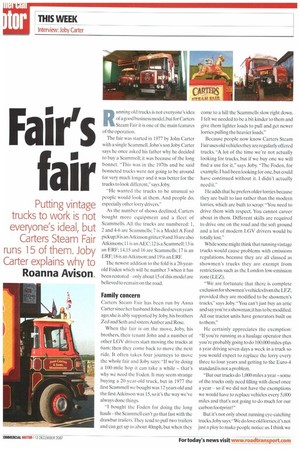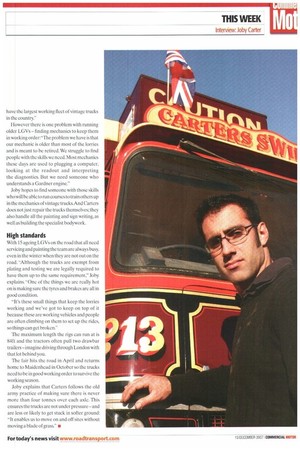Fair's fair
Page 24

Page 25

If you've noticed an error in this article please click here to report it so we can fix it.
Putting vintage trucks to work is not everyone's ideal, but Carters Steam Fair runs 15 of them. Joby Carter explains why to Roanna Avison.
Running old trucks is not everyone's idea of a good business model, but for Carters Steam Fair it is one of the main features of the operation.
The fair was started in 1977 by John Carter with a single Seammell. John's son Joby Carter says he once asked his father why he decided to buy a Scammell; it was because of the long bonnet. "This was in the 1970s and he said bonneted trucks were not going to be around for very much longer and it was better for the trucks to look different," says Joby.
"He wanted the trucks to be unusual so people would look at them. And people do. especially other lorry drivers."
As the number of shows declined, Carters bought more equipment and a fleet of Scammells. All the trucks are numbered: 1, 2 and 4-6 are Scammells; 7 is a Model A Ford pickup; 8 is an Atkinson gritter; 9 and 10 are also Atkinsons; II is an AEC; 12 is a Scammell; 13 is an ERF; 14,15 and 16 are Scammells; 17 is an ERF; 18 is an Atkinson; and 19 is an ERF.
'The newest addition to the fold is a 20-yearold Foden which will be number 3 when it has been restoredonly about 15 of this model are believed to remain on the road.
Family concern
Carters Steam Fair has been run by Anna Carter since her husband John died seven years ago; she is ably supported by Joby, his brothers Zed and Seth and sisters Amber and Rose.
When the fair is on the move. Joby, his brothers, their tenant John and a number of other LGV drivers start moving the trucks at Oam; then they come back to move the next ride. It often takes four journeys to move the whole fair and Joby says: "If we're doing a 100-mile hop it can take a while that's why we need the Foden. It may seem strange buying a 20-year-old truck, but in 1977 the first Scammell we bought was 12 years old and the first Atkinson was 15, so it's the way we've always done things.
"I bought the Foden for doing the long hauls -the Scammell can't go that fast with the drawbar trailers.They tend to pull two trailers and can get up to about 40mph, but when they come to a hill the Scammells slow right down. I felt we needed to be a bit kinder to them and give them lighter loads to pull and get newer lorries pulling the heavier loads."
Because people now know Carters Steam Fair uses old vehicles they are regularly offered trucks, "A lot of the time we're not actually looking for trucks, but if we buy one we will find a use for it.says Joby. "The Foden, for example. I had been looking for one, but could have continued without it. I didn't actually need it."
He adds that he prefers older lorries because they are built to last rather than the modern lorries, which are built to scrap: "You need to drive them with respect. You cannot career about in them. Different skills are required to drive one on the road and the soft ground and a lot of modern LGV drivers would be totally lost."
While some might think that running vintage trucks would cause problems with emissions regulations, because they are all classed as showmen's trucks they are exempt from restrictions such as the London low-emission zone (LEZ).
"We are fortunate that there is complete exclusion forshowmen'svehieles from the LEZ, provided they are modified to be showmen's trucks," says Joby. "You can't just buy an artic and say you're a showman;it has to be modified. All our tractor units have generators built on to them."
He certainly appreciates the exemption: "If you're running as a haulage operator then you're probably going to do 100,000 miles-plus a year driving seven days a week in a truck so you would expect to replace the lorry every three to four years and getting to the Euro-4 standard is not a problem.
"But our trucks do 1,000 miles a year some of the trucks only need filling with diesel once a year so if we did not have the exemptions we would have to replace vehicles every 5,000 miles and that's not going to do much for our carbon footprint!"
But it's not only about running eye-catching trucks. Joby says: "We do love old lorries:it's not just a ploy to make people notice us.! think we have the largest working fleet of vintage trucks in the country."
However there is one problem with running older LGVs — finding mechanics to keep them in working order: "The problem we have is that our mechanic is older than most of the lorries and is meant to be retired. We struggle to find people with the skills we need. Most mechanics these days are used to plugging a computer, looking at the readout and interpreting the diagnostics. But we need someone who understands a Gardner engine."
Joby hopes to find someone with those skills who will be able to run courses to train others up in the mechanics of vintage trucks. And Carters does not just repair the trucks themselves; they also handle all the painting and sign writing, as well as building the specialist bodywork.
High standards With 15 ageing LGVs on the road that all need servicing and painting the team are always busy, even in the winter when they are not out on the road. "Although the trucks are exempt from plating and testing we are legally required to have them up to the same requirement?' Joby explains. One of the things we are really hot on is making sure the tyres and brakes are all in good condition.
"It's these small things that keep the lorries working and we've got to keep on top of it because these are working vehicles and people are often climbing on them to set up the rides, so things can get broken."
The maximum length the rigs can run at is 84ft and the tractors often pull two drawbar trailers— imagine driving through London with that lot behind you.
The fair hits the road in April and returns home to Maidenhead in October so the trucks need to be in good working order to survive the working season.
Joby explains that Carters follows the old army practice of making sure there is never more than four tonnes over each axle. This ensures the trucks are not under pressure—and are less or likely to get stuck in softer ground: "It enables us to move on and off sites without moving a blade of grass." •






















































































































































































